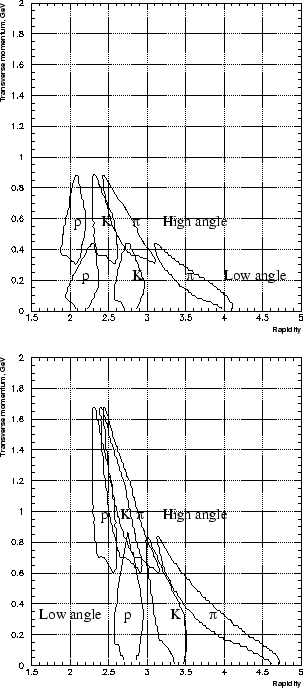



Next: Means of particle identification
Up: The NA44 Experiment
Previous: The Si pad detector
Contents
Kopytine's homepage
Spectrometer ``optics'' and acceptance.
A magnet system of two dipoles and three superconductive focusing
quadrupoles, together with a tracking complex (a pad chamber,
three highly segmented scintillation hodoscopes H2, H3, H4 and two
strip chambers, see Fig.3.1) provides momentum resolution of 0.2%
or better for all spectrometer settings.
The quadrupoles allow for two modes of focusing - vertical and horizontal.
The distinction between them plays a role in HBT analysis; in the single
particle analysis the horizontal mode has always been used.
The spectrometer accepts charged particles of a single charge at a
time.
The magnet system is mounted on a rotating platform and was operated
at two angular positions (44 and 131 mrad).
The data analyzed are taken with two different field strengths.
In the weak field mode, spectrometer accepts charged tracks in the
momentum range of  GeV
GeV ,
and of
,
and of  GeV
GeV in the strong field mode.
These two field modes are often called ``the 4 GeV/c'' and
``the 8 GeV/c'' settings, respectively.
Location of the acceptance area in rapidity
in the strong field mode.
These two field modes are often called ``the 4 GeV/c'' and
``the 8 GeV/c'' settings, respectively.
Location of the acceptance area in rapidity  and transverse momentum
and transverse momentum  varies
with field strength, arm angle, and particle mass, as is shown on Fig.
3.3.
For
varies
with field strength, arm angle, and particle mass, as is shown on Fig.
3.3.
For  and
and  , the acceptances are located within one unit of
, the acceptances are located within one unit of  around the
center-of-mass rapidity of the SPS
around the
center-of-mass rapidity of the SPS  system (
system (
 )
)
![[*]](file:/usr/local/lib/latex2html/icons/footnote.gif) .
.
Figure 3.3:
Acceptance area of the NA44 spectrometer in the laboratory rapidity  and transverse momentum
and transverse momentum  .
Top: in the weak field mode; bottom: in the strong field mode.
.
Top: in the weak field mode; bottom: in the strong field mode.
 |
The magnitude of the spectrometer's acceptance is largely restricted by
the factor
 (typically around 0.02)
representing narrowness of the azimuthal coverage.
Within the spectrometer's
acceptance at
(typically around 0.02)
representing narrowness of the azimuthal coverage.
Within the spectrometer's
acceptance at  GeV/c for a midrapidity pion,
the remaining factors would amount to about 0.5.
In the low angle setting during the
GeV/c for a midrapidity pion,
the remaining factors would amount to about 0.5.
In the low angle setting during the  run, a tungsten collimator (the so
called ``jaws'') was introduced into the magnet system in order to reduce the
multiplicity of tracks in the spectrometer.
Its effect on the acceptance has been computed via Monte Carlo and
corrected for in the analysis.
A more detailed discussion of these issues will be given in
Section 4.1.
run, a tungsten collimator (the so
called ``jaws'') was introduced into the magnet system in order to reduce the
multiplicity of tracks in the spectrometer.
Its effect on the acceptance has been computed via Monte Carlo and
corrected for in the analysis.
A more detailed discussion of these issues will be given in
Section 4.1.




Next: Means of particle identification
Up: The NA44 Experiment
Previous: The Si pad detector
Contents
Mikhail Kopytine
2001-08-09


![]() (typically around 0.02)
representing narrowness of the azimuthal coverage.
Within the spectrometer's
acceptance at
(typically around 0.02)
representing narrowness of the azimuthal coverage.
Within the spectrometer's
acceptance at ![]() GeV/c for a midrapidity pion,
the remaining factors would amount to about 0.5.
In the low angle setting during the
GeV/c for a midrapidity pion,
the remaining factors would amount to about 0.5.
In the low angle setting during the ![]() run, a tungsten collimator (the so
called ``jaws'') was introduced into the magnet system in order to reduce the
multiplicity of tracks in the spectrometer.
Its effect on the acceptance has been computed via Monte Carlo and
corrected for in the analysis.
A more detailed discussion of these issues will be given in
Section 4.1.
run, a tungsten collimator (the so
called ``jaws'') was introduced into the magnet system in order to reduce the
multiplicity of tracks in the spectrometer.
Its effect on the acceptance has been computed via Monte Carlo and
corrected for in the analysis.
A more detailed discussion of these issues will be given in
Section 4.1.